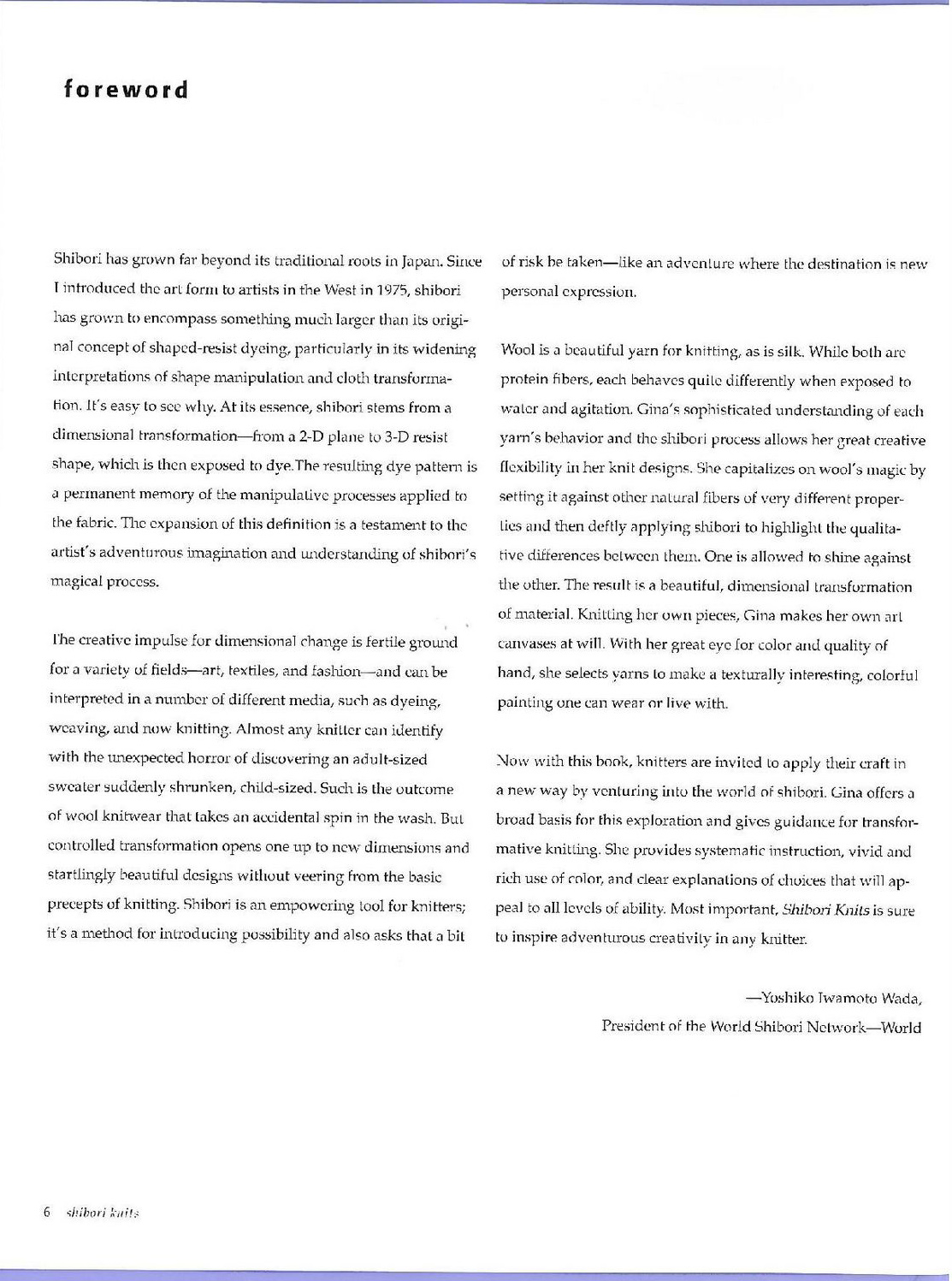38887 S20C 409120813101

f o reword
Shibori has grown far beyond its traditional roots in Ja pan. Since I infrodticed tho arl form to artists in the West in 1975, shibori lias grown to encompass something much larger tlian its or i ginął concept of shaped-resist dyeing, particularly in its widening inlcrpretations of shape manipulation and cloth transforina-tion. it's easy lo scc why. At its essence, shibori stems from a dimensional trans forma tion—bom a 2-D piane to 3-D resist shape, which is thcn exposed to dye.The resnlting dye pattem is a permanent nipmor)' of the manipulalivc processes applied to the fabric. The cxpansion of this definition ;s a testament to the artist's adventnrous imagination and undcrstanding of shibor;'s magicai proccss.
I he creativc impulse for dimensional rbange is fertile ground for a yariety of field.9—art, texhles, and fashion—and canbe interpreted in a number oi diffcrent media, such as dyeing, wcaying, and now knitting. Almost any knillcr can identify with the unexpected horror of discovering an adult-sized swcater suddenly shrunken, child-sized. Such is the outcome of wool knitwear that lakcs an accidental spin in the wash. Bul controlled trans forma tion opens one up to ncw dimensions and startlingiy beautiful dcsigns witliout yeering from the basie precepts of knitting. Shibori is an empowering lool for knitters; it's a method for inlroducing possibility and also asks that a bil of risk be taken—iike an advcnLure where the destination is new personal cxpression.
Wool is a beautiful yarn for knitting, as is silk. Whilc bolh arc protein fi bers, each behavcs quilc differently when exposed to walor and agitation. Gir»a's sophisticated undcrstanding of each yam's be.havior and the shibori process allows ber great creative flexibility in her knit designs. She capitaiizes on wooKs magie by setting it against other nalural fibers of very differenr propen lies and then deftly applying shibori to highlighl the qualita-tive difteren ces belween them. One is allowed to shine against tłie other. The result is a beautiful, dimensional transformation of materiał. Knitting her own pieces, Giną makes her own arl canvases at will. With her great eyc for color and quality of hand, she seiects yarns lo make a texturally interesting, coloriul painting one can wear or live with.
Mo w with this book, knitters are inyited lo apply their eraft in a new' way by venluring into the world of shibori. Giną offers a broad basis for this exploration and givcs guidance for transfor-mative knitting. She provides system a fi c insfruction, vivid and rich use of rnlor, and elear explanalions of clioices that will ap-peal to all lcvcls of ability. Most important Shibori Knils is surę to inspire adventurous creativily in any knitter.
—Yoshiko Twamoto Wada, President ot the World Shibori Nclwork—World
6 shibori ktiU*
— —
Wyszukiwarka
Podobne podstrony:
S20C 409120813342 s u b 11 e shibori Shibori knitting has no limits when the door is openeri wide Lo
S20C 409120813340 Take shibori to the next level—make the Portrait Scarf (page 110), the 5 il Vous P
S20C 409120813341 subtle shibori Double Dog Dare You Capelet 84 1 Wanna Hołd Your I land Warmers 88&
THE COGNlTlVE PROCESSES AND ORIENT A TION IN THE EN VIR ON MEN T Summary Psychology today has got fa
S20C 409120813433 appendix Lechnical Shibori Fetting Concepts lmportanl generał diaracterishcs of sh
S20C 409120813072 contentsłoreword 6prefaceintroduction 10chapter one surrentler to shibori elegant
S20C 409120813160 surrender to shibori Buuquet Wrap 20 Happy Colored Marbles Scarf 24 Wood Grain Sca
S20C 409120813321 shibori fez continued Level Intsmedidte Knittod Measurements Before felling Ciicum
S20C 409120813441 Care of Shibori knits Though I am gcnerally nol a fan of dry deaning, I do rerom m
41637 S20C 409120813393 s il vous plait kimono In muny ways, Shibori is the knitting apiwalcnt ofnot
więcej podobnych podstron